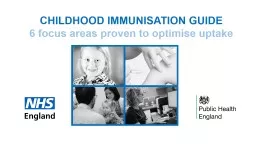

6 focus areas proven to optimise uptake 6 focus areas proven to optimise uptake of immunisations Strong leadership Proactive promotion Maintain accurate information Effective callrecall Maximise access and continuity ID: 914022
Download Presentation The PPT/PDF document "BEST PRACTICE CHILDHOOD IMMUNISATION GUI..." is the property of its rightful owner. Permission is granted to download and print the materials on this web site for personal, non-commercial use only, and to display it on your personal computer provided you do not modify the materials and that you retain all copyright notices contained in the materials. By downloading content from our website, you accept the terms of this agreement.
Slide1
BEST PRACTICE
CHILDHOOD IMMUNISATION GUIDE6 focus areas proven to optimise uptake
Slide26 focus areas proven to optimise uptake of immunisations
Strong leadership
Proactive promotion
Maintain accurate information
Effective call/recall
Maximise access and continuity
Trained and knowledgeable workforce
Slide31.
Strong LeadershipAppoint a designated practice lead for immunisations (see Appendix 1)
Adopt a multi-disciplinary team approach
Discuss children/families who persistently miss appointments in practice meetings and routinely liaise with health visitors
Plan aheadStrive for continuity of care
Slide42.
Proactive Promotion
Promote vaccinations within the surgery, for example using national resources
https://www.orderline.dh.gov.uk/ecom_dh/public/home.jsf
Have conversation starters in reception e.g. the ‘MMR bear’
Slide53.
Maintain accurate informationMaintain accurate immunisations recordsAlways check the immunisation status of new registrations (and share this information with CHIS – Child Health Information Service)
Send regular information to CHIS of children moving in and out, and any vaccinations given
Slide6Maintain accurate information (contd)
Routinely check the immunisation status and eligibility of all patients during health appointmentsSchedule regular searches of the IT system (e.g. quarterly) to identify and follow up patients with outstanding immunisations or who have DNA’d (and their parents as appropriate) - ensure this is highlighted in the notes
Set up IT system alerts on patient records as a reminder to encourage parents if there are outstanding vaccinations
Slide74.
Effective call/recallAdopt a call–recall chain of escalationBe flexible to patient needs
Minimise/eliminate vaccination waiting lists
Put in place a vaccination DNA management policy
Consider text messaging, ‘birthday cards’, ‘parties’ and other innovations
Slide85.
Maximise access and continuityEnsure clinics (and the practice as a whole) are child and family friendly
Review the immunisation clinics to see if improvements can be made (e.g. extended clinic/opening times, no waiting lists)
Maximise opportunistic vaccination – make every contact count
Slide9Ensure access to language and learning development support is readily available
Ensure sufficient vaccine stock, safe storage and availability during clinicsKeep the cold chain policy up-to-dateBe proactive about understanding and addressing barriers to access and inequalities – Appendix 3
Maximise access and continuity (contd)
Slide106.
Trained and knowledgeable workforce
Ensure that all immunisers are up-to-date with training (and provide general immunisation training to reception staff) https://www.england.nhs.uk/south/info-professional/public-health/training/
Remember your ‘8 Rs’ (Royal College of Nursing guidance) – Appendix 2
Train and develop staff that will be responsible for ensuring uptake is optimised
Use friendly competition
Slide11Trained and knowledgeable workforce (contd)
Sign up to Vaccine Update to be aware of any national issues or changes https://www.gov.uk/government/collections/vaccine-update
Save useful internet links as favourites so you can find them easily, such as the incomplete immunisation sheet https://www.gov.uk/government/publications/vaccination-of-individuals-with-uncertain-or-incomplete-immunisation-status
Slide12Support
If you would like any support or more information, please contact the SW screening and immunisation team: england.swscreeningandimms@nhs.net
Support
Slide13a practice lead for immunisations
The responsibilities of the practice lead should include (not limited to):
Appendix 1: Appoint a practice lead for immunisations
Slide14a practice lead for immunisations
Appendix 2:
Remember your
‘8 Rs’
https://www.rcn.org.uk/-/media/royal-college-of-nursing/documents/publications/2018/october/pdf-007201.pdf
Slide15Appendix 3: Inequalities
What are the needs of your local population – how would you find this out?
Who doesn’t attend/engage - how can you find out why?
What could the barriers to access be?
Inequalities are seen across a range of dimensions like: age, gender, ethnicity, disability, geography, socio-economic factors (wealth, education, language)
Specific groups may be more vulnerable such as people with learning disabilities, informal carers, looked-after children
How can the practice:
Improve access to services and information?
Engage communities?
Target specific groups?
Collect better data or evidence?
Be proactive: Prepare, Assess, Refine, Apply, Review!